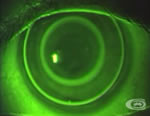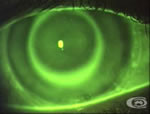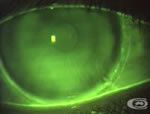|
Recently there have been several studies examining refractive
changes with silicone hydrogels. 1-3 These studies
clearly show that the refractive response to silicone hydrogel
lenses differs when compared to conventional hydrogel materials.
Conventional hydrogel contact lenses lead to small increases
in myopia whilst changes with silicone hydrogels rarely occur.
The effect with conventional hydrogel materials is believed to
be
a result of hypoxia, and has been shown to reverse when patients
are dispensed with lenses with higher oxygen transmissibility.
For a review of the general issues surrounding refractive changes
and silicone hydrogel lens wear see Kathryn Dumbleton’s
excellent editorial Refractive
Error and Corneal Curvature Issues with Silicone Hydrogel Lens
Wear.
Unintended ‘orthok’?
In addition to the studies described above there have been
a few anecdotal reports from practitioners describing a significant
increase in hyperopia or reduction in myopia, particularly with
patients with relatively high refractive error, whilst wearing
their silicone hydrogel lenses.4 Very recently at
the International Contact Lens Congress Meeting in Australia,
Ray Fortescue, a
practitioner with more than 20 years private practice in Sydney,
reported that approximately 12% of his hypermetropic patients
experience up to a +2.00D shift with silicone hydrogel lenses.
He associated these effects with corneal flattening and has found
that if patients are changed to a daily wear schedule, or are
refit with a lower modulus lens material, then the effects can
be reduced.
The cause or mechanism behind these changes is still unclear.
The refractive changes do not occur immediately or consistently
in the same people and in some instances the changes are unilateral.
Practitioners agree that the evidence points towards corneal
moulding or “ortho k” type effects. Indeed John Mountford
has reported topographic changes to the cornea characterised
by central corneal flattening and a ring of mid-peripheral corneal
steepening, similar to that observed after reverse geometry lens
wear in orthokeratology (see Unintended
Orthokeratology effect of Silicone Hydrogels on Hypermetropic
patients).
One explanation for why these large refractive shifts are occurring
is that patients are inadvertently wearing their silicone hydrogel
lenses inside-out. This would explain the inconsistencies in
the occurrence of the problems. Also, when observing the tear
profile beneath an inverted lens and comparing this with a lens
correctly inserted, the evidence for this hypothesis is quite
startling (Figures 1, 2 and 3). As can be observed in
the picture of the reverse geometry lens used for intentional
orthok (Figure 1), there is minimal central corneal
clearance and relatively high corneal clearance in the midperiphery
with the inverted silicone hydrogel lens (Figure 2).
The same silicone hydrogel that is inserted the correct way (Figure
3) has a more even distribution of corneal
clearance. It is interesting to note that the higher the power
of the silicone hydrogel lens (whether it be positive or negatively
powered), the more the inverted fluorexon image resembles a reverse
geometry orthok lens fluorescein pattern.
The corneal re-shaping effects orthok lenses have on the cornea
are believed to be the result of positive and negative forces
present in the tears. Therefore, positive pressure would be present
beneath the central portion of the lens where there is minimal
clearance producing corneal compression or flattening and negative “suction” pressures
would be present beneath the reverse curve where the tear profile
is thickest producing corneal steepening.5 It is thought that
these hydraulic forces in the tears, rather than the physical
pressure of the lens itself, is responsible for the corneal re-shaping.
 |
 |
 |
Click to enlarge |
Click to enlarge |
Click to enlarge |
| Figure 1: Fluorescien pattern of an
R&R Reverse geometry lens from Danker Laboratories
(USA) |
Figure 2: Fluroexon pattern of an
inverted +5.00 inverted Focus Night and Day lens |
Figure 3: Fluorexon pattern of a correctly
inserted +5.00 Focus Night and Day lens on the same eye
as Figure 2 |
Comfort and Vision with Inverted Silicone Hydrogel Lenses
Lens handling is difficult even for experienced wearers and
hyperopes are more at risk of problems with handling due to their
reduced visual capabilities at near. Practitioners generally
advise their patients that they are likely to be aware that their
lenses are inverted as they will not be as comfortable and vision
may be affected. Although published work on this is scarce, clinical
experience with conventional contact lens materials makes this
fairly obvious. However, our experience with silicone hydrogel
lenses indicate that patients are less likely to be aware of
incorrect lens insertion with silicone hydrogel lenses than with
conventional hydrogel lenses if they are to rely on comfort and
vision cues.
We observed this after conducting a short pilot study looking
at the vision and comfort of inverted lenses compared to lenses
worn the correct way. Both comfort and vision were dramatically
lower with inverted Acuvue 2 lenses compared to Acuvue 2 inserted
the correct way but there were no differences in comfort and
vision between the majority of inverted and correctly inserted
Focus Night & Day lenses tested ( Figure 4). Interestingly,
the performance of some of the inverted Focus Night & Day
lenses was actually better compared to when they were inserted
the correct way!
|
| Figure 4: Subjective
comfort and vision ratings comparing inverted lenses to
those inserted the correct way for –3.00
Acuvue 2 and –3.00 Focus Night & Day lenses |
Summary
With all the evidence so far, it is clear that patients are
able to wear their silicone hydrogel lenses comfortably while
they are inverted. It is also clear that inverted silicone hydrogel
lenses can produce significant changes in refractive error (i.e
an increase in hyperopia or decrease in myopia), particularly
higher powered lenses. The question now is, are all the anecdotal
reports from practitioners regarding “unintended” orthok
solely due to incorrect lens insertion? Some practitioners are
adamant that their patients are having the problems despite correct
lens insertion, therefore other issues may still need to be considered.
References
- Dumbleton KA, Chalmers
RL, Richter DB, Fonn D. Changes in myopic refractive error
in nine months' extended wear of hydrogel lenses with high
and low oxygen permeability. Optom Vis Sci 1999;76:845-9.
- McNally J, McKenney C. A clinical look at a silicone hydrogel
extended wear lens. Contact Lens Spectrum 2002;January:38-41.
- Jalbert I, Stretton S, Naduvilath T, Holden B, Keay L, Sweeney
D. Changes in myopia with low Dk hydrogel and high Dk silicone
hydrogel extended wear. Optom Vis Sci 2004;Accepted for publication,
March 2004.
- Saks A. Beware extended wear. NZ Optics Magazine 2003;August:14-5.
- Mountford J, Noack D. BE Optimal Orthkeratology, BE Enterprises
QLD, 2001.
|